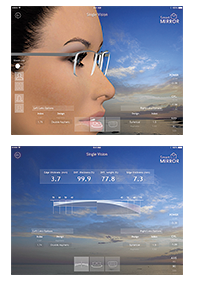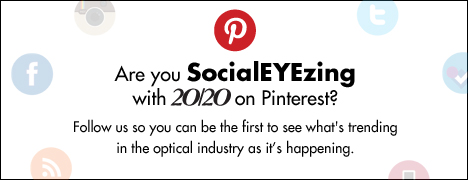|
Your monthly guide to staff training outside the box
Eyes / Lenses / Fitting Lenses / Free-Form / Frames / Sunwear / Patient Solutions/ In-office / Standards
Best Eyewear vs. Best Value
Prescription eyewear can be purchased for anywhere from $7 to $1,000-plus. What’s the difference, and how should the consumer think about what’s best for them and the value of eyewear? I suggest that the best and the most value is the same; it’s a function of the dollars spent, the product sold and the way you’ve taught the consumer its benefits.
—Mark Mattison-Shupnick
HIGH INDEX, THINNESS AND LIGHTNESS IS VALUE
 It’s powerful and very professional to be able to immediately show a patient what they get when they pay more. Imagine that you’re sitting with a patient. They have a -4.50-1.50 x 90 prescription.
It’s powerful and very professional to be able to immediately show a patient what they get when they pay more. Imagine that you’re sitting with a patient. They have a -4.50-1.50 x 90 prescription.
Say, “Let me show you the latest in thinner, lighter lenses.” Using lens demonstration software, show the face of the woman model with prescription, -4.50D sphere, -1.50D cylinder, axis 90 degrees.
Then, choose the right lens to show how much thinner and lighter the lenses are with higher index materials, digital surfaces, etc., along with the cost of the various options.
Rotate the face to show the edge comparison. Show the two frame view so that it’s clear how much thinner it looks. Use the cross-section illustration to see edge thinness and savings as well as weight savings. Lenses are half the edge thickness and 72 percent lighter. That’s significant.
Show a few of the other options and quote what they might cost, then come back to the best so the patient can weigh the value of what they are seeing and make an investment in their final eyewear.
See Plus »
|
SOCIAL MEDIA TEACHES VALUE
Millions of sunglasses are sold every year, but are not being sold by the three “Os” (optometrists, ophthalmologists and opticians). In fact, a recent study by The Vision Council’s VisionWatch (studied 12 months through March 2015) shared that the three Os claimed a disappointing 2 percent of all sunglass sales. Use social media to help sell plano sunglasses in your office. Here are some ideas:
Kids: Focus on the importance of kids’ protection—take photos of the doctors’ and teams’ kids wearing sunglasses on their bike, at the beach or trying them on in your optical.
Contests: Are you trying to grow your audience (likes and follows) on your social media platforms? Consider a running contest to give away sunglasses for free. “Every person who likes or shares our Facebook page will be entered in our contest to win a free pair of shades. This contest will run for one month… start liking and sharing now!”
Give away one free pair of sunglasses each month for four consecutive months (March to June), and watch your Facebook, Instagram and Twitter followers grow.
Testimonials: Have your happy clients share video testimonials on your YouTube channel. Or maybe they’ll feel more comfortable writing something up for you which could be displayed on your Facebook page and website.
Sunwear trivia: Which celebrity is shown wearing Ray-Ban on this week’s issue of Us Weekly? Which sunglass line is loved by fishing experts, especially off the Florida coasts? Why are polarized sunglasses recommended as the best option for protecting your eyes from glare? Pick a small prize for the winner(s).
Social media can be fun and highly valuable. It’s all about showcasing your products and your clients. Give clients a say and feature them on your social media platform to engage others while connecting with them in an effective way.
See Plus »
|
|


|
MAKE IT JEWELRY FOR YOUR EYES
The in-store customer experience adds value where the online experience may be more identified as the less money definition of value. How can the in-store experience add value?
Less is more, make sure to always keep the store pristine and balanced in terms of visual merchandising. What should be the consumer’s journey through your store?
First, ATTRACT: A store window is literally a “window into a new world.” It’s where the first visual contact takes place and shows what’s inside. Dramatic lighting, strong graphic elements, color and sound are essential in the windows and storefront.
Next, DISCOVER: The center area features a style bar that engages the customer in discovering new collections and styles. Revolving fixtures, graphics, visuals and product keep the store fresh.
Then, DECIDE: Clean product presentation at the perimeter walls encourage the customers to explore options so they can easily find their style and pick the frames that are right for them. The optician can offer answers about the DNA of brands and the technological benefits of lenses and frames.
Finally, CELEBRATE: Upon final selection of the perfect glasses, the customer’s purchase is celebrated at the reception desk.
See Plus »
|
SHOULDN’T LENS EFFECTIVE POWER BE EQUAL TO THE PRESCRIPTION?
A customer with -6.00 sphere prescription, with a 61 PD in a great vintage Wayfarer comes back into your office and says, “My vision, it’s not as clear as my previous glasses.” The prescription checks out correctly, no lens waves or aberrations that I can see and, the previous glasses were the same -6.00 sphere, though in a small oval frame. What in the world could be different—they measure the same!
But they ONLY perform the same in the lensmeter... not in front of their eyes!
Here’s a possibility that happens with higher prescriptions. Vertex distance affects the power of the lenses as the eyes see through them. Not everyone may have the right position and posture when being behind the refractor or phoropter; it could be as little as 14 mm and as much as 26 mm. Turns out that the distance the lens’ back surface is to the eye affects the positional effective lens power, not the power of the lens itself. In fact, that’s true for both the refraction and the way that the lenses in the glasses fit. That means that a -6.00D sphere prescription is correct in eyeglasses if the lenses are also fit at the same distance as the lenses in the refactor were from the eye.
See Plus »
|
EDUCATE PATIENTS ABOUT BLUE LIGHT
Exposure to UV rays and harmful blue light are both on the minds of Americans, but a large majority of people do not know these types of light share a source, according to a Transitions Optical, Inc., consumer survey conducted by Wakefield Research. When asked which types of light are harmful to the eyes long term, most people identify sunlight (76 percent agree), as well as light from digital screens like computers or smartphones (61 percent believe this). Only 4 percent of respondents, however, can correctly identify all common sources of blue light (digital devices and screens, fluorescent lights, incandescent light bulbs and the sun).
The sun is 100 to 500 times more intense than electronic devices and screens—and that’s a conservative number. Some feel that because the intensity of the sun is so strong, other sources are irrelevant.
Here are three points to consider:
The harm done to the human retina by high-energy light is cumulative. Every source adds to the damage. It’s just not possible to avoid the sun entirely while living a normal life. Likewise, it’s not possible to avoid sources of damaging blue light indoors.
It’s not a choice between outdoor protective lenses or indoor protective lenses. Patients would be best served by both outdoor protective lenses and indoor protective lenses.
You don’t want to block all blue light all the time. There is good blue light and bad blue light. The band of light most harmful to the retinal pigment epithelial cells is 415 to 455 nm. That 40 nm band of light causes the maximal cell death. It would be good to block this band of blue light. On the other hand, blue-turquoise light in the band from 465 to 495 nm is essential to the function of the human pupillary reflex, helps regulate the Circadian sleep/wake cycle and has been implicated in memory, mood and hormonal balance. It would be good to let this band of blue light pass through unblocked.
See Plus »
|
|


|
|